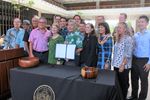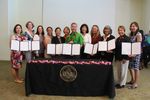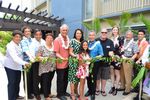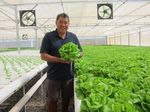From the governor: What it will take to sustain Hawai'i - Governor David Ige
←
→
Page content transcription
If your browser does not render page correctly, please read the page content below
Courtesy Tyler Kruse
August 2018
From the governor: What it will take to sustain Hawai‘i
S ustainability for our islands means a host of things: protecting our people and our environment, providing living wage jobs
and affordable housing, and producing more of our own food with sustainable strategies. This issue describes some of the
ways the governor and his administration are working with the community to take action — now and for the future.
Q. Does your definition of sustainability go beyond protecting the environment?
A. Yes, for me sustaining Hawai‘i is part of a bigger mission of changing our economy
so we can be more self-reliant. Instead of sending billions of dollars out of state for
fuel or food, we need to generate more of our own energy and increase local food
production. Then we could keep that money in our economy and have more capital
for education, business development and job creation. I do think people are con-
necting the dots to see that protecting the environment, expanding clean energy,
increasing food production and supporting innovation in every sector helps us all.
AFFORDABLE RENTALS: Gov. Ige, Ahe Group CEO Makani Maeva and her
daughter join officials and residents at a recent Waipahu Tower blessing.
Q. Over the years, others have talked about the same issues of housing, jobs,
education, the environment and food security. What has the Ige administration done differently to move the needle?
A. We’ve encouraged our departments to be “smart risk-takers” if it means delivering better results for taxpayers. In affordable hous-
ing, we revamped our processes to support public-private partnerships and made financing tools more attractive to encourage build-
ing more affordable units. We’ve reduced homelessness statewide two years in a row because we changed the contracts so more ser-
vice providers are working together, focusing on moving people to permanent, supportive housing instead of just filling shelter beds.
And we’re supporting game-changers like Early College and Hawai‘i’s Promise to give students a head start on higher-paying jobs.
Q. What about concerns over balancing land and water for housing and agriculture?
A. Conditions have changed dramatically from the ’80s when sugar and pineapple were big players and I was a legislator helping to
write the state’s water code. Back then, the concern was to protect plantation lands. Now we have an abundance of ag-zoned land all
across the state that’s lying fallow. What we need are more people to farm and help for those who want to expand production but
can’t afford to take the risk. At our urging, the state’s Water Commission is getting stakeholders together to balance farming and
housing needs instead of going to court. Also, with new, efficient greenhouse technology, the conflict between housing development
and ag land preservation is no longer such a big issue.
Q. What do you think of the Trump administration’s separation of migrant families? Concerns about the trade war?
A. The separations are an inhumane answer for people desperately seeking a better life. I can’t imagine how terrifying it must be for
the children to be in a strange land, separated from their family and not knowing when they’ll be able to see them again. As for the
tariffs on foreign goods, business people I talk with say they anticipate pervasive, higher prices on goods. The global supply chain
means it’s rare to buy an American manufactured product that has no foreign materials, so the costs will be passed on to consumers.
Q. What has been the most gratifying part of being governor? The most challenging part?
A. The best part is being able to see projects completed and programs working to improve people’s lives. The biggest challenge is you
can’t pick and choose your issues. You have a responsibility to make some hard decisions for which there are many differing opinions.
In our social media world everyone has a platform, where the minority can sound as loud as the majority. But you can’t please every-
one so you just have to make the best decisions you can for the good of the community.Hawai‘i becomes first to ban reef-damaging sunscreens
W ith the stroke of a pen, Governor Ige made Ha-
wai‘i the first place in the world to ban the sale
of sunscreens with the chemicals oxybenzone and oc-
tinoxate, effective Jan. 1, 2021. At the signing ceremony,
the governor said, “Our natural environment is fragile,
and our own interaction with the Earth can have lasting
impacts. This new law is just one step toward protecting
the health and resiliency of Hawai‘i’s reefs.”
The event in the Capitol rotunda drew representatives
from the Friends of Hanauma Bay, the Surfrider Founda- PROTECTING REEFS: Gov. Ige and legislators gather at the Capitol for the historic bill signing.
tion and The Kohala Center of Hawai‘i island. They called the ban“historic” and praised the state for leading the way on the issue.
“This bill has enormous significance,” said Sen. Roz Baker. “By signing this measure, you are presenting our community with a
unique moment in time to protect our coral reefs.” Rep. Chris Lee added, “In my lifetime, our planet has lost about half its reefs.
We’ve got to take action to make sure we can protect the other half as best we can because we know time is against us.”
Bill signing: New laws from the hard work of many
B ill signings may look like just ceremonial photo
ops, but they represent the culmination of a
long legislative process to provide meaningful change
for the community. Governor Ige reviewed 228 bills
from the 2018 legislative session for legal and policy
implications, along with public input. “I take all of that
into account and ask, ‘Is it the right thing to do, does
it do it in the right way, and does it benefit the people
of Hawai‘i?’ It’s a responsibility I take very seriously,” he said.
Some of the bills the governor has signed into law this year include:
•Eight bills from the Women’s Legislative Caucus, including a paid family
leave report (SB 2990), preserving Affordable Care Act benefits (SB 2340)
and creation of a Sexual Assault and Training Program (HB 2131).
• SB 2046 (Act 157) – Prohibits bump stocks and multi-burst devices,
such as were used in the deadly Las Vegas shooting. HPD Chief Susan
Ballard also announced a 30-day amnesty program to turn in bump The Women’s Legislative Caucus holds copies of their signed bills (top).
stocks at any police station or to call 9-1-1 for officers to pick it up. HPD Chief Susan Ballard and advocates join Gov. Ige and legislators for the
signing of the bill banning bump stocks and other multi-burst devices.
•SB 2790 (Act 105) – Expands basic rights for children in foster care.
•HB 2607 (Act 51) – Requires all public high schools in the state to offer at least one computer science course by 2021.
•SB 2087 (Act 145) – Amends the Good Samaritan Law to provide civil liability exemptions for saving someone with a rescue tube.
•SB 3058 (Act 149) – Establishes a pilot project to revitalize the Hilo Community Economic District.
•SB 2293 (Act 150) Maui Front Street Apartments – appropriates rental housing revolving funds to expedite affordable housing.
•Comprehensive bill package for the Hawai‘i Opioid Initiative, including warning labels and preventing overprescription of drugs.
FEMA individual aid approved
P ersistence and determination at every level — from emer-
gency response teams who went door-to-door to govern-
ment officials who wouldn’t give up — paid off in getting federal
aid to Kaua‘i and O‘ahu families hard hit by the severe floods.
In a June 27 news conference, Governor Ige announced the presi-
dent had approved the state’s appeal of a Major Disaster Declara-
tion for individual assistance. The approval paves the way for resi-
DISASTER AID APPROVED: Gov. Ige, mayors Kirk Caldwell and Bernard Carvalho
dents affected by the floods to apply to federal programs that and FEMA’s Dolf Diemont deliver the good news for O‘ahu and Kaua‘i families.
include disaster crisis counseling, disaster unemployment assis-
tance, and FEMA grants for home repairs and temporary housing. For locations of Disaster Recovery Centers and other ques-
tions, go to http://dod.hawaii.gov/hiema/frequently-asked-
Dolf Diemont, FEMA coordinating officer, praised the state’s questions-federal-assistance-and-disaster-recovery-centers/.
efforts, calling it “a model of how you respond to a disaster.” The deadline to apply for FEMA aid is Aug. 27, 2018.Finding the game-changers for local food production
“
F arm to table” sounds fresh and appealing — like going to your
nearest farmer’s market — but how many of us really know the
hard work it takes to grow food? So when Governor Ige set doubling
local food production as one of his administration’s goals, skeptics
wondered, “Is that even possible?” The answer is yes, say state agri-
culture officials — with the right combination of available land and
water, public-private investment, more support for current and future
farmers, and new technology, such as high-tech, climate-controlled
greenhouses on a scale that can make a difference for diversified ag.
It’s a complex matrix of pieces and a far cry from the days when large
USGS Johnny Gordines.
Gov. Ige with Kaua‘i County Farm Bureau President
plantations took care of everything — from housing the workforce to
quality assurance and distribution. Increasing local production includes supporting current growers as well as planning for a new
kind of farming that relies less on back-breaking labor and more on “smart” technology to increase productivity. Determined
farmers, aquaculture entrepreneurs and ag innovators are working with the state to increase Hawai‘i’s food security, but they
need more support. “Currently, only 15 percent of food consumed in Hawai‘i is actually produced here,” said the governor. “We
Photo by Marc Schechter
need to move island agriculture from the plantation era into the 21st century. That means combining sustainable practices with
new technology to help current small farmers and attract a new generation of growers.”
The Ige administration has taken action on several fronts to make the transition to diversified agriculture possible, including:
• Preserving thousands of acres of prime agricultural land statewide for food production and coordinating water-related policies
• Providing farmers and aquaculture operators with $8.1 million in loans and state long-term leases
• Developing public-private partnerships for greater capital investment
• Encouraging new farmers through business incubators and ag tech to help them become more productive
• Building community awareness through farm-to-table movements and the ‘Aina Pono, farm-to-school program
• Revitalizing dairy, egg and livestock production as well as employing new greenhouse technology and sustainable DBEDT/US
practices
Japan Council
New greenhouse technology - The game-changer for the future may be increased
use of climate-controlled greenhouses that can grow more produce on a small
The state takes action to protect the islands from climate change.
amount of land. “This is the new generation of farming,” said James Nakatani, execu-
tive director of the Agribusiness Development Corporation (ADC). “It’s super compact
and very productive compared with needing thousands of acres to farm.” For the past
few years, Fred Lau, owner of Mari’s Garden in Mililani has been working with ADC to
field test systems at the largest aquaponics greenhouse in the state. Every month
Mari’s turns out 36,000 heads of baby romaine for several O‘ahu hotels and military
commissaries. The pilot project comes from a $2 million collaboration between the
state and Mari’s Garden to showcase best practices for hydroponic/aquaponic systems Mari’s Garden owner Fred Lau with his baby romaine.
and greenhouse design. Now the plan is to take what’s been learned about greenhouse design adapted to the islands’ heat and
humidity and build a next-generation greenhouse in Wahiawa, using sustainable practices and energy-efficient technology.
Whitmore Food Hub - The Hub is part of a master plan to make Central O‘ahu a major source of
local food production. “To create a system for diversified ag and to meet new federal food safety
standards, we’ve been working with Sen. Donovan Dela Cruz to bring together land development,
infrastructure, renewable energy, ag tech research and training for 21 st century jobs,” said ADC staff-
er Todd Low. A design for a Whitmore Food Hub recently won a prestigious 2018 American Architec-
ture Award for being among the 100 best new building designs in the United States.
Villa Rose - A cage-free farm being built on former Dole Pineapple land on O‘ahu is expected to
produce eggs by spring 2019. The farm is planned to be off the grid, with solar panels and battery
storage. Up to one million laying hens will occupy the farm, to be built in phases over several years.
Kunoa Cattle Co. – A Kaua‘i-based ranch with the state’s largest USDA-inspected slaughterhouse
on O‘ahu that produces grass-fed beef from 2,000 cattle. Named “Best New Business” in 2017 by
Pacific Edge, its co-founder Bob Farias is a third-generation rancher who combines healthy grazing
practices with sustainable systems.
The Whitmore Food Hub design (top).
Bobby Farias of Kunoa Cattle Co.
“We’re assembling the pieces for a foundation we can take into the future,” said Nakatani.“With
the threat of climate change and new federal food safety regulations, we’re focusing on sustainable, “green,” energy-efficient
technology and strategies that can benefit farmers statewide to increase productivity and create jobs.”Governor acts to preserve, create more affordable housing
T he Ige administration is
ramping up the state’s
efforts to provide more housing
for low-and moderate-income
families. “Our goal is to create as
many affordable units as possible
— especially for families in the 30
to 60 percent area median income
range,” said the governor.
On Maui, Gov. Ige signed SB 2293
that aims to produce more afford-
able housing on the Valley Isle, while preserving affordable
rentals at the Front Street Apartments in Lāhainā. The new
law mandates the Hawai‘i Housing Finance
Photo courtesy ofand
Hawai‘Develop-
i National Guard
ment Corporation (HHFDC) to begin the process of condemn-
ing the ground lease. It also appropriates $30 million from the
state’s Rental Housing Revolving Fund to expedite the devel-
opment of 200 multi-family rental units at the Keawe Street
Apartments in Lāhainā. In Kaka‘ako, the governor joined the
Hawai‘i Community Development Authority in signing
Front Street residents celebrate; Keahumoa Place, another affordable rental in Kapolei.
amendments to HCDA rules that stipulate units in the area
must remain affordable for at least 10 years. “Thanks to HCDA chair John Whalen and the board for listening to the community,”
said Gov. Ige.“It’s about balancing production and affordability to make more units available for our residents.”
Three more O‘ahu projects also got under way last month with state-assisted financing. They include Waipahu Tower, an
affordable rental housing project for families earning 60 percent and below the area median income (AMI). The eight-story
building is an acquisition/rehabilitation project set to remain affordable for 59 years. A second project is Nohona Hale in Ka-
ka‘ako, being built on state HCDA land near the HART rail station. The 111 micro-units also received state financing assistance
and are targeting families earning 30 to 60 percent AMI. The third project is Keahumoa Place, a 320-unit planned community
near the Kapolei Rail Station. Phase I will consist of 75 units and will provide affordable family rentals at 60 percent AMI for 65
years. Estimated completion for Phase I is 2019-2020.
‘Aina Pono wins high marks
T he ‘Aina Pono Hawai‘i State Farm to School program has
earned five-stars from some of its toughest customers: the
students. “Who wouldn’t want fresh, locally grown fruits, vege-
tables and beef instead of canned food?” said one high schooler.
Thanks to a public-private partnership spearheaded by the Lieu- Lt. Gov. Doug Chin with Mililani High students.
tenant Governor’s office, the pilot project that began in the Ko- meals for students. “We plan to expand the program to other
hala district has expanded to Mililani High School, Mililani Uka schools and continue the ‘Harvest of the Month’ to highlight
and Mililani Waena elementary schools. “The students and ad- more local foods,” said Albert Scales, the Department of Educa-
ministration of Mililani High School gave ‘Aina Pono high marks,” tion’s food services branch administrator.
said Lt. Governor Doug Chin. “They’ve tasted the difference,
and their excitement is spreading to other schools.” Private funders who have helped make the program possible
include Ulupono Initiative, The Kohala Center, HMSA Founda-
Chin and others see the program as a step toward Governor tion, Johnson ‘Ohana Charitable Foundation, Kaiser Perma-
David Ige’s goal of doubling local food production and improving nente, The Dorrance Family Foundation, and the Hawai‘i Apple-
food security for the entire state. It’s a win-win for local farmers seed Center. It also recently received a $100,000 grant from the
to expand demand for their goods while providing healthier U.S. Department of Agriculture for expansion and training.
Contact us at governor.hawaii.gov Capitol Connection with Gov. David Ige is a regular e-newsletter that provides updates
Executive Chambers, State Capitol
Honolulu, HI 96813
from the State Capitol. As we work to become paperless, the newsletter is available online and
Phone: (808) 586-0034 | Fax: (808) 586-0006 via subscription. Check the governor’s website at governor.hawaii.gov to subscribe. Also, follow
Hilo Office (808) 974-6262 | Kona Office (808) 323-4542 | the governor on Twitter and Instagram @govhawaii and https://www.facebook.com/
Maui Office (808) 243-5798 | Kaua‘i Office (808) 274-3100 GovernorDavidIge. (Print copies by Hawai‘i Correctional Industries)You can also read



























































